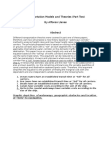Transportation Models and Theories (Part Two
By Alfonso Llanes
Different transportation theories were covered in part one of these papers, therefore, part two will propose a new theory based on " waterways corridor " method to analyze freight rates and how these freight rates can be established by carriers. The principle proposed here is based on routing traffic through ocean, air, or ground corridors each with a " toll " at each segment the route either from the applicable international water corridors or the domestic traffic lanes to a final destination. This paper focus on ocean freight only and will derive a corresponding equation based on the " tolling " of traffic corridors and the fact that all carriers must use the same trade lanes. This argument can be reduced to a numerical expression with two parameters: Knowns and unknowns where every ship entering the trade corridor has a " toll " known factor of distance-cost no matter what the size of the ship is. It follows that domestic sea-lanes are the next " toll " to be added which is also a known quantity, so, the remaining unknowns are the variable quantities of canal crossings and destination seaboard ports-costs. Therefore, this argument simplifies the equation to the problem of finding the marginal cost with one dependent and one independent variable based on the following facts: 1. Ocean routes have an established transit time or " toll " for all carriers. 2. Sea Lanes have an established transit time or " toll " for all carriers. 3. Straits have an established transit time or " toll " for all carriers. 4. Canals have variable costs according to the size of the ship. 5. Ports in the coastal waterways have variable costs according to the size of the ship. Graphic depiction of waterways, geographic obstacles and location of " tolls " to navigation.